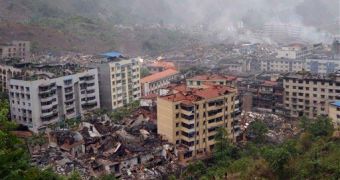According to a new study, the 9.3 magnitude earthquake that took place in the Indian Ocean in late 2004 and that was said to have unleashed the energy equivalent of 1.3 billion tons of TNT, or 100,000 Hiroshima bombs, killing over 225,000 people in the outcome of the resulted tsunami, could have generated other earthquakes around the world. The event remains in history as one of the worst naturally occurring disasters and the second largest earthquake ever registered.
Only two weeks ago, another massive earthquake registering a magnitude of 7.9 on the Richter scale took place in mainland China and may have also generated smaller earthquakes around the world, even in areas that are not predisposed to seismic activity, although the available data is insufficient to confirm the theory at this time.
Until 1992, researchers had no idea that large earthquakes may cause other smaller ones in distant areas of the globe, but then realized that smaller earthquakes in the Yellowstone National Park might have been in some way related to the 7.3 magnitude earthquake that hit California. Further investigations the same year proved the theory correct, albeit the distance on which the effect could be felt was still unknown.
So in order to find out, seismologists started analyzing 15 other earthquakes with a magnitude of 7 or higher which took place since the 1990s, including the Indian Ocean earthquake and the Turkey earthquake in 1999.
The results of the study revealed that 12 of these earthquakes generated surface waves that traveled across the surface of the whole planet, setting off smaller earthquakes, such as those in Alaska, California and Ecuador triggered by the Indian Ocean quake. The Earth experiences about 600 small seismic events once every five minutes, but in the outcome of large earthquakes this number doubles. The Indian Ocean one for example, is said to have generated five times more small quakes than usual, none of which with a magnitude greater than 4.
Earthquakes generate two types of surface waves, Love and Rayleigh waves, which travel in a shearing respectively rolling fashion through the surface, but how they are able to generate small earthquakes at great distances is unknown.
"The passage of the waves may change the water flow in a fault, possibly increasing the number of conduits that water can flow through which could cause the fault to slip", said Kris Pankow from the University of Utah. Alternatively, such waves may be able to increase the strain on a specific fault causing it to give way sooner than expected.
In the case of the Chinese quake that occurred two weeks ago on the other hand, the rate of smaller quakes seems to have remained constant, although only the data from the mainland US stations was so far analyzed. Data from stations from around the world may have another story to tell.
"But do large quakes trigger other large quakes? Probably not. But we really need to better understand how stresses from these earthquakes are doing the triggering, the dynamics of what's happening", Velasco said.

 14 DAY TRIAL //
14 DAY TRIAL //